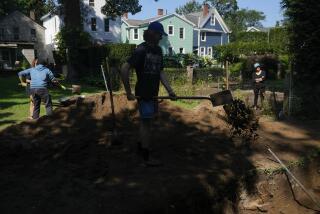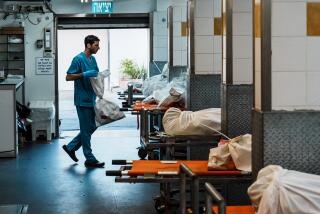18th Century Bones Hint of a Woman’s Hard Life
- Share via
ALBANY, N.Y. — She died before this country was born, buried in a plain pine box and forgotten.
She lay in the ground as a colonial settlement grew into a modern city. A street was paved over her, a drain line dug nearby, then a utility trench.
Despite the close calls, she was not discovered until last year when a state archeological crew found her brittle brown bones in repose in her coffin.
Now, for the first time in more than 250 years, she’s getting attention. A team led by an archeologist from the New York State Museum is teasing out details of her life through the unearthed evidence.
They’ve already deduced some things: She likely died about age 40, between 1720 and 1740. Short and muscular, she suffered from a range of health problems, including rickets, bad sinuses and bad teeth.
As clues are collected, museum sculptor Gay Malin will attempt to put a face on anonymous bones by adding facsimiles of muscle and flesh to a cast of the pieced-together skull.
It’s painstaking and frustrating work, a jigsaw puzzle with pieces forever missing. Chances of discovering the woman’s name are remote. But Malin and archeologist Charles Fisher have already caught glimpses of a real person in the bones.
Malin holds the skull Hamlet-style to describe what the face will look like. “She’s really a live person to me,” she says. “I can see her.”
The woman lived in a time when Albany was small but bustling, with maybe 1,100 residents within the stockade walls.
Livelihoods centered on trading of fur, lumber and grains, while others--the woodworkers and tanners--made money from their crafts.
In the early 18th century, the city hugged the Hudson River, on the edge of the frontier. Grandchildren of settlers from France, England, Ireland, Germany and Scandinavia walked streets paved with stones. Indians involved in fur trade stopped by. More than 10% of the people were black American slaves, said historian Stefan Bielinski.
Back then, Albany featured a British fort on a hilltop, streets filled with buildings of brick, and a little Lutheran church on the unpaved periphery.
The woman was buried in the church graveyard.
In 1786, as the city grew, Albany officials paid to have graves removed to make way for a street. Three graves, including this one, were left behind. No one knows why.
Last year, Fisher’s archeological crew began digging at the site, now at the downtown intersection of South Pearl and Howard streets. The state wanted to widen Pearl, and such exploratory digs are common given Albany’s long history.
Sure enough, the crew uncovered three coffins fairly well preserved in the clay-packed soil. Two held remains of males, one thought to be in his early 40s, the other in his late 20s. Lower portions of those remains were missing, apparently scooped up when a water line was laid in 1906. The female was in better shape and attracted more attention.
Unfortunately, none had personal effects: no rings, no Bibles, no clue as to their names.
Soil and artifacts on top of the coffins date to early in the 18th century, leading Fisher to conclude the woman died around that time. Bielinski guessed that the Lutherans would have included most farmers and workers of German and Scandinavian ancestry.
Physical anthropologists say the bones reveal a 40-ish woman, 5 feet 1 inch tall. The skull indicates a small face with a receding chin, a puckered mouth with only seven teeth. Patterns of wear suggest a high-starch diet, maybe from routine meals of local corn or wheat.
Ridges attest to muscles. But a bow to the leg indicates a childhood bout of rickets--a vitamin D deficiency. There is evidence her bones grew slowly in her youth, which could be related to a serious illness or poor nutrition. Bone scars suggest upper respiratory and sinus infections.
“My gut feeling is this person had a hard life,” Fisher said.
Her developed muscles might point to a laborer of some sort. A domestic servant? That could help explain her plain, and later forgotten, burial. Such a burial could also have been a custom of the time, unrelated to social class. Why would a worker, presumably someone outdoors quite a bit, contract rickets?
The answers are lost to history.
“Everything you learn, there’s a million other questions,” Fisher said.
Malin is considering the question of face, cribbing techniques of police forensic investigators to create features from the skull mold. She will fill in what the bones can’t tell: ears, eyelids, hair based on best guesses; nose open to interpretation.
But context provides clues.
A woman from Northern Europe would likely be fair. With 40 years of hard life, Malin can add crow’s feet and lines to her face. Beyond that, she can mix science and art to illustrate personality she feels in the bones. “My job is to let the bones speak,” she said.
Eventually, the reconstructed face will be exhibited at the State Museum in Albany.
The bones are headed for a second, perhaps eternal, resting place. The First Lutheran Church of Albany will bury all remains May 15 in a cemetery just north of the city.
The gravestone will read, in part: “Remains of three persons known but to God . . . rest in peace.”
More to Read
Sign up for Essential California
The most important California stories and recommendations in your inbox every morning.
You may occasionally receive promotional content from the Los Angeles Times.










